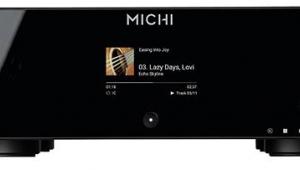ATC CDA2 Mk2 CD player/DAC/preamp

 With an upgraded specification including an asynchronous USB input with DSD capability, ATC’s CD player/DAC/preamp aims to be a complete system front-end
With an upgraded specification including an asynchronous USB input with DSD capability, ATC’s CD player/DAC/preamp aims to be a complete system front-end
Is this a new twist on the CD player? Or yet another new variation on the DAC? Well, neither actually, for as that ‘Mk2’ suffix suggests, this is a revised version of ATC’s innovative CDA CD player/DAC/preamp combination, selling for £2950 and designed as the perfect partner for the company’s £3375 P2 power amplifier [HFN Mar ’17], or its range of active speakers.
Combine the CDA2 Mk2 with the P2, which has a more-than-healthy 300W per channel output, and you have a simple two-box system with both CD playback and plenty of inputs – both analogue and digital – able to drive a wide range of speakers. Combine it with a pair of ATC’s active speakers, the company suggesting the SCM19A as a starting point, and you have a minimalist set-up, albeit one capable of very high standards of performance.
Elegant Solution
As a result, the CDA2 Mk2’s mixture of facilities is something of a masterstroke in simplifying what could be a multi-component system. Then again, there will be those who sound a note of caution, as they would with any multifunction device of this kind: in what is still a rapidly-evolving digital audio market, buying such a product might be putting too many eggs in one basket. After all, while the CDA2 Mk2 might be convenient, it is prey to the appearance of future formats requiring decoding or processing beyond its capabilities, and appears to have no clear upgrade route through modular design or firmware updates.

And, of course, there are formats and services already available to which the CDA2 Mk2 doesn’t provide access. So it may handle files up to DSD256, but it won’t play SACDs, and neither does it have any streaming capability onboard. If you want to play music from network or Internet sources, then you will have to do so via a computer connected to the USB-B input provided, or add a dedicated network music player. And with line analogue inputs only, turntable users will have to add an offboard phono stage, too.
ATC's Velvet Sounds
So the CDA2 Mk2 is a comprehensive solution, if not a complete one. Mind you, it compares favourably on price with contemporary products. For example, the AVM Evolution CS 5.2 offers a similar specification, plus onboard 330W amplification, and is about twice the price of the ATC unit – or a bit less than the CDA2 Mk2/P2 combination.
The CDA2 Mk2 uses a Chinese-made TEAC drive to spin the CDs and includes the celebrated AK4490 DAC from Asahi Kasei. Part of AKM’s Verita Series, and using what the company calls its ‘Velvet Sound’ architecture, the AK4490 supports up to 768kHz/32-bit PCM (the CDA2 Mk2 uses this capability up to 384kHz) and 11.2MHz DSD, and offers a choice of five digital filter settings. However, ATC has decided not to give the user direct access to these filters, choosing what it thinks sounds the best and making this the default mode [see PM’s Lab Report].
The DAC also receives data from the CDA2 Mk2’s range of digital inputs, including USB-B, coaxial and optical. The USB audio input requires downloadable drivers for use with Windows computers, but is driverless with Macs – what is unusual, however, is that it will support DSD256 when used with Windows, but only DSD128 with OS X machines.
The output of the DAC stage, and the three analogue inputs (one of which is of higher sensitivity, and provided on a 3.5mm stereo socket instead of a pair of RCA phonos) feed into a fully-balanced preamp stage on the main board stretching the width of the rear of the housing. Even the 6.35mm headphone socket, driven by its own amplifier, is on the rear panel to keep signal paths short, and the front panel controls are ‘fly by wire’ rather than being coupled mechanically to the audio board.
Also notable is the abundance of fresh air inside the CDA2 Mk2. While sometimes derided by those who feel they’re only getting their money’s worth if the interior of a product is crammed with circuitry, this actually has advantages when it comes to keeping sound-critical components away from potential sources of interference.
As an aside on the same subject, it’s worth noting that the main audio board has a clear circular ‘landing pad’ marking for the toroidal transformer, complete with a hole drilled for its mounting bolt. In the original CDA2 this is where the transformer was mounted, but in the Mk2 the location is unoccupied. Instead, the transformer is bolted in vertical orientation to the right-hand side-panel of the unit – presumably as this location distances it from the audio circuits, further reducing interference and noise.
























































